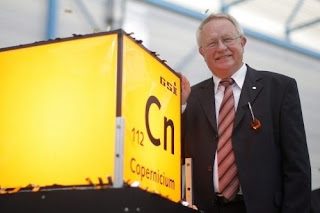Introduction Additional Information Chemical Properties Physical Properties Name Origin Uses
Located at Group 12 and Period 7 of the Periodic table is one of the Radioactive man - made element which there's not much to be known. This is Copernicium.
First discovered by Sigurd Hofmann in 1996. And because it is a man - made element, Copernicium is also created ( not isolated, since it's a man - made element ) by Sigurd Hofmann.
There's not much information about Copernicium but it is certain that Copernicium is formed by the fusion of lead and zinc atoms in an Heavy Ion accelerator.
Besides, there is only few atoms made and its most stable ones' half life is only approximately 28 seconds.
So, Copernicium is only created in labaratories for research purposes.
 |
| Sigurd Hofmann and his Copernicium exhibition |
First discovered by Sigurd Hofmann in 1996. And because it is a man - made element, Copernicium is also created ( not isolated, since it's a man - made element ) by Sigurd Hofmann.
There's not much information about Copernicium but it is certain that Copernicium is formed by the fusion of lead and zinc atoms in an Heavy Ion accelerator.
 |
| Ultra - Wide angle of the Heavy Ion Accelerator |
Besides, there is only few atoms made and its most stable ones' half life is only approximately 28 seconds.
So, Copernicium is only created in labaratories for research purposes.
Atomic Number : 112
Name : Copernicium ( Copernicum for American English )
Latin Name : Copernicum
Electrons per shell : [ 2, 8, 18, 32, 32, 18, 2 ]
Discoverer : Sigurd Hofmann
Creator ( not isolator ) : Sigurd Hofmann
Element's : Atomic Mass : ( 285 ) ( predicted )
: Density : 23.7 ( predicted )
: Type : Transition Metals
Chemical Properties :
- Unreactive ( estimated )
- 7 types of isotopes : 3 of them are :
Copernicium - 277 : Protons : 112
: Neutrons : 165
: Electrons : 112
Copernicium - 227 isotope
( Half Life : 1.1 milliseconds )
Copernicium - 285 : Protons : 112
: Neutrons : 173
: Electrons : 112
( Half Life : 29 seconds )
Copernicium - 286 : Protons : 112
: Neutrons : 174
: Electrons : 112
( Half Life : 8.45 seconds )
Physical Properties :
- A heavy metal
- seems to look like a noble gas rather than metal.
- Very very Radioactive!
- Melting Point : 10 degrees Celsius ( 50 Fahrenheit ) ( predicted )
- Boiling Point : 67 degrees Celsius ( 152.6 Fahrenheit ) ( predicted )
How Copernicium got its name?
Originally, Copernicium was supposed to be named as Ununbium. Until 2010, Ununbium was change to be named after Nicholas Copernicus, a famed astronomer as well as matematician. Of course, Copernicium was immediately suggested a symbol ( Cp ). However, it was already used by Lutetium at that time, which is called Casseiopium. So, scientists voted to name Copernicium ( Cn ).
Uses
Actually, Copernicium is only used for researching purpose as its half life is only 29 seconds maximum. So, Copernicium is only used in a science lab.
THIS IS THE END OF COPERNICIUM
To go to homepage, click this link :
Our Homepage
To go to Chemistry Element page, click this link :
garnetchemistryelement.blogspot.com
To go to homepage, click this link :
Our Homepage
To go to Chemistry Element page, click this link :
garnetchemistryelement.blogspot.com
Thanks for visiting.
If there is any improvements needed, feel free to comment at the comment section below.
Thank you.
If there is any improvements needed, feel free to comment at the comment section below.
Thank you.




No comments:
Post a Comment